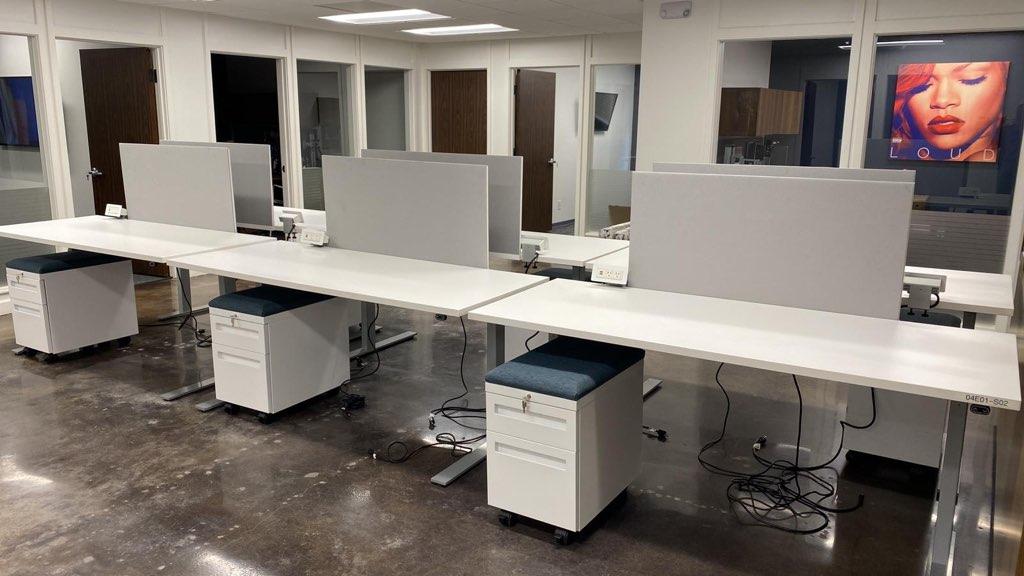What is an Office Workstation?
In the contemporary workplace, the term "office workstation" encompasses far more than just a desk and chair. It represents an entire ecosystem designed to enhance efficiency, comfort, and collaboration among employees. But what exactly is an office workstation, and how can used office furniture be a sustainable and cost-effective solution to create a functional workspace? In this article, we will delve into the world of office workstations, shedding light on their purpose and the advantages of utilizing used office furniture to craft a dynamic and environmentally friendly workspace.
The Essence of an Office Workstation
An office workstation is a designated area where an employee carries out their daily tasks. It is a personalized space where an individual's work-related activities are concentrated, allowing them to access necessary tools, resources, and technology easily. In essence, an office workstation serves as the epicenter of an employee's productivity and contributes to their overall comfort and job satisfaction.

Components of an Office Workstation
A typical office workstation comprises several key components that work in synergy to create an efficient and ergonomic workspace. These components may include:
- Desk: The desk is the central element of the workstation. It provides a surface for work, supports computer equipment, and often includes storage space such as drawers and shelves.
- Chair: An ergonomic chair is vital for maintaining comfort and preventing musculoskeletal issues. It should be adjustable to accommodate various body types and promote good posture.
- Computer and Accessories: A computer or laptop, along with accessories like a keyboard, mouse, and monitor, is essential for most office tasks.
- Storage Solutions: Storage options like filing cabinets, bookshelves, and storage drawers help keep the workspace organized and free from clutter.
- Lighting: Adequate lighting, whether from natural sources or artificial fixtures, is essential for reducing eye strain and maintaining productivity.
- Ergonomic Accessories: Items such as monitor stands, keyboard trays, and footrests can enhance comfort and ergonomics.
- Personalization: Personal touches like photos, plants, or decorations can make the workspace feel inviting and motivating.
The Role of Used Office Furniture
While many businesses invest in brand-new office furniture, there is a growing trend towards sustainability and cost-effectiveness by opting for used office furniture. Here are some compelling reasons to consider used office furniture for your workstations:
- Cost Savings: Used office furniture is considerably more budget-friendly than new items. This cost-effective choice allows businesses to allocate resources to other essential areas while still providing quality workstations for employees.
- Sustainability: Buying used furniture is an environmentally responsible choice. It reduces the demand for new resources and minimizes waste, contributing to a more sustainable workplace.
- Quality and Durability: Many used office furniture pieces are constructed to withstand years of use. These pieces may have minor wear and tear but are often structurally sound and can serve for an extended period.
- Variety and Customization: Used furniture offers a wide range of styles and options. It allows businesses to find unique pieces that fit their specific aesthetic and functional requirements, enhancing the overall office ambiance.
- Rapid Availability: Used office furniture is readily available, making it a convenient choice for outfitting workstations without extended lead times.

Creating an Efficient Office Workstation
To optimize an office workstation and promote productivity, consider the following tips:
- Ergonomics: Prioritize ergonomics by selecting adjustable chairs, keyboard trays, and monitor stands. Proper ergonomics can enhance employee comfort and reduce the risk of workplace-related injuries.
- Organization: Implement effective storage solutions to keep the workspace organized. This reduces clutter, enhances efficiency, and minimizes distractions.
- Personalization: Encourage employees to personalize their workstations with items that inspire and motivate them. A touch of personalization can boost job satisfaction and morale.
- Lighting: Ensure that workstations have adequate lighting to minimize eye strain. Consider natural light sources and task lighting options for optimal illumination.
- Quality Furniture: Whether new or used, invest in quality office furniture that can withstand the rigors of daily use. Well-constructed furniture can have a significant impact on the longevity and functionality of the workstation.
In conclusion, an office workstation is more than just a desk and a chair; it is a personalized space where employees engage in their daily tasks. Utilizing used office furniture in creating these workstations can be a sustainable, cost-effective, and environmentally responsible approach. By carefully selecting components and focusing on ergonomics, organization, and personalization, businesses can create workstations that promote productivity and comfort, enhancing the overall work environment.
Comments
Post a Comment